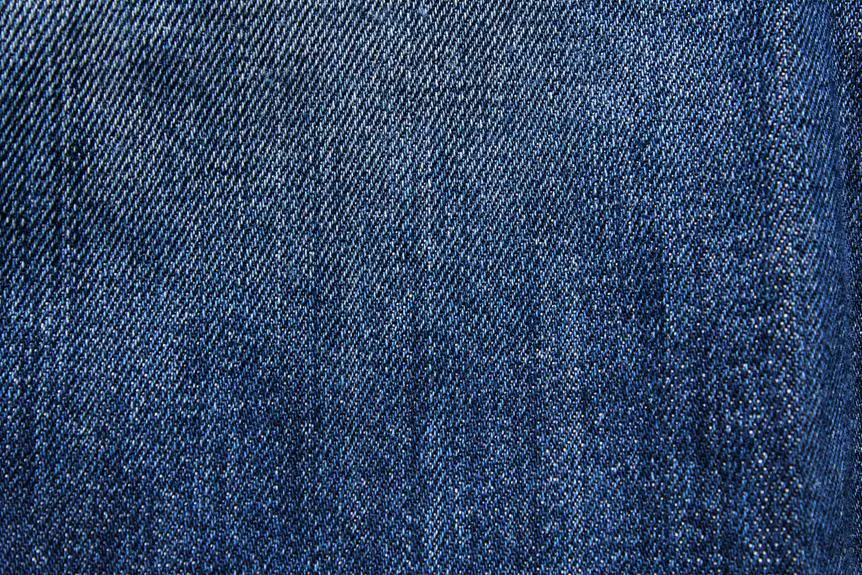When you compare batiste and denim, you quickly notice that these fabrics serve very different purposes. Batiste, with its lightweight and sheer quality, is perfect for airy summer garments, while denim boasts a heavier, more robust feel suited for rugged wear. Each fabric comes with its own set of care requirements and applications, which can greatly influence your wardrobe choices. But what happens when you need to decide between the two for a specific project? Understanding their unique characteristics can significantly impact your decision-making process.
Table of Contents
Fabric Composition
When it comes to fabric composition, batiste is typically made from lightweight cotton or linen, while denim is crafted from heavier cotton twill, giving each a distinct feel and purpose.
Batiste's fine, sheer texture makes it perfect for delicate garments like blouses and summer dresses. It drapes beautifully, allowing for comfortable, breathable wear, especially in warmer temperatures. You'll appreciate its softness against your skin, making it a go-to for lightweight clothing.
On the other hand, denim's sturdy composition makes it ideal for more rugged applications. The tightly woven cotton twill gives denim its durability, making it a favorite for jeans, jackets, and workwear. You can trust that denim will withstand wear and tear, making it a long-lasting choice in your wardrobe.
While batiste offers elegance and comfort, denim provides functionality and strength. Each fabric serves different needs, so consider the occasion and your personal style when choosing between them.
Whether you're looking for something airy and light or durable and robust, understanding the fabric composition helps you make informed decisions for your clothing choices.
Weight and Thickness
When comparing batiste and denim, you'll notice significant differences in weight and thickness.
Batiste is lightweight and airy, making it perfect for delicate garments.
In contrast, denim's thicker, denser fabric offers durability and flexibility for everyday wear.
Understanding these characteristics helps you choose the right fabric for your projects.
Fabric Density Comparison
Comparing the fabric density of batiste and denim reveals significant differences in weight and thickness that affect their suitability for various applications.
Batiste is a lightweight, sheer fabric, often made from cotton or a cotton blend. It typically weighs between 2 to 4 ounces per square yard, making it ideal for delicate garments like blouses and summer dresses. Its thinness allows for breathability, which is perfect for warmer weather.
On the other hand, denim is a much heavier fabric, usually weighing between 10 to 14 ounces per square yard, depending on its weave and finish. This substantial weight gives denim its characteristic sturdiness, making it well-suited for items that require durability, such as jeans and jackets. The thicker construction contributes to denim's ability to hold its shape and resist wear.
When choosing between batiste and denim, consider the project's specific needs. If you're crafting something lightweight and airy, batiste is your go-to. However, for robust, long-lasting garments, denim is the clear choice. Understanding these density differences helps you make informed decisions for your sewing projects.
Durability and Flexibility
Durability and flexibility in fabrics like batiste and denim stem largely from their weight and thickness, influencing how each performs in various applications.
Batiste is lightweight and thin, making it an excellent choice for delicate garments like blouses and linings. Its fine fibers allow for breathability but can lead to wear and tear over time, especially in high-friction areas. If you're looking for a fabric that drapes beautifully but doesn't stand up to heavy use, batiste might be your go-to.
On the other hand, denim is known for its sturdiness and greater thickness. This fabric can withstand considerable stress and wear, which is why it's commonly used for jeans and workwear. Denim's weight gives it a structured feel, offering both durability and flexibility, allowing for ease of movement without sacrificing strength. If you want something that lasts through years of use, denim's the better choice.
Texture and Feel
When you touch batiste, you'll notice its lightweight, silky texture, contrasting sharply with denim's sturdy, rugged feel.
You'll appreciate how each fabric's composition affects its surface smoothness and breathability.
Understanding these differences can really enhance your comfort and style choices.
Fabric Composition Differences
Batiste offers a lightweight, silky texture that feels soft against your skin, while denim's sturdy composition provides a more robust and rugged feel.
When you wear batiste, you'll notice how breathable and airy it is, making it perfect for warm weather or layering. This fabric's fine fibers create a delicate drape that enhances comfort, allowing you to move freely without restriction.
On the other hand, denim's thicker weave gives it a more structured quality. It's designed for durability, so it can withstand daily wear and tear. You'll appreciate the weightiness of denim, especially when you need something that offers protection and longevity. The fabric's resilience also means it can break in over time, molding to your body shape and creating a personalized fit.
In terms of care, batiste's lightweight nature often requires more delicate handling, while denim's robust fibers can endure rougher washing conditions.
Surface Smoothness Comparison
The smooth surface of batiste feels luxurious against your skin, while denim's texture is typically more coarse and rugged.
When you touch batiste, you'll notice its fine, soft finish, which makes it perfect for delicate garments like blouses and summer dresses. This silk-like feel not only adds elegance but also enhances your overall comfort when wearing it. You might even find that batiste drapes beautifully, creating a graceful silhouette.
In contrast, denim's thicker weave gives it a sturdy, robust feel. While it can be comfortable in its own right, you're more likely to feel the weight and texture of denim against your skin. This ruggedness is what makes denim ideal for casual wear, such as jeans and jackets, but it doesn't offer the same softness that batiste provides. You may also find that denim requires a break-in period to soften up, while batiste is ready to wear right away.
Ultimately, your choice depends on the occasion and desired aesthetic. If you're after a soft, elegant feel, batiste is your go-to. For a durable, casual vibe, denim fits the bill perfectly.
Breathability and Comfort Levels
Breathability plays a crucial role in how comfortable each fabric feels against your skin, especially in varying temperatures. Batiste, being a lightweight and airy fabric, allows for excellent airflow, making it a great choice for hot days. You'll feel fresh and unrestricted when wearing it, perfect for summer outings. On the other hand, denim, while durable and stylish, tends to be thicker and less breathable. You might find it gets a bit warm during sweltering weather.
Here's a quick comparison to help you visualize the differences:
| Fabric | Breathability |
|---|---|
| Batiste | High – Lightweight |
| Denim | Low – Thick |
| Comfort | Soft and airy |
| Comfort | Stiffer and heavier |
Ultimately, if you prioritize breathability and comfort, batiste is your go-to option. Denim, while versatile and classic, can sometimes feel restrictive. So, consider your activities and the climate when choosing between these two fabrics. The right choice can make all the difference in your comfort levels throughout the day.
Breathability and Comfort
When it comes to comfort, many find that batiste offers superior breathability compared to denim, making it a preferred choice for warm weather. The lightweight and airy nature of batiste allows air to circulate freely, helping you stay cool and comfortable throughout the day. You'll notice that it feels soft against your skin, reducing the chance of irritation, especially during hot summer months.
On the other hand, denim tends to be heavier and can trap heat, leaving you feeling warmer than you'd like. While some denim fabrics have improved breathability, they still can't match the lightweight feel of batiste. If you're planning to spend time outdoors or engage in activities where you might sweat, batiste is likely to keep you feeling fresher.
Moreover, batiste's smooth texture makes it an excellent choice for layering without the bulk. You can easily wear it under other garments without feeling constricted. So, if you're after comfort and breathability, batiste is the way to go. When selecting your wardrobe for warmer days, consider prioritizing batiste to ensure you stay cool and comfortable all day long.
Durability and Strength
Batiste may win in breathability, but denim clearly takes the lead in durability and strength. When you're looking for fabric that can withstand wear and tear, denim is your go-to choice. Its tightly woven structure gives it exceptional resilience, making it ideal for everyday use. Whether you're climbing a mountain or simply running errands, denim can handle the rigors of your lifestyle.
In contrast, batiste is lightweight and delicate, which means it won't stand up to heavy use. While it shines in comfort and flow, it's prone to tearing and fraying, especially in high-stress areas. If you're seeking something to last through multiple washes and rough conditions, batiste just can't compete with denim's robust nature.
Denim also holds up well to fading, which is great if you love that lived-in look. It can be cleaned frequently without losing its shape or integrity. Ultimately, when it comes to durability and strength, you'll find that denim is a fabric that not only meets your needs but exceeds them, making it a worthy investment in your wardrobe.
Common Uses and Applications
Denim's versatility makes it a staple in casual wardrobes, often seen in jeans, jackets, and skirts. When you think about everyday wear, denim's durability and style make it perfect for various occasions, from casual outings to more polished events. You can easily dress it up or down, pairing denim with a t-shirt for a laid-back look or a blazer for a more refined appearance.
On the other hand, batiste is favored for its use in lightweight blouses and summer dresses. It is ideal for warm weather due to its lightweight and breathable nature. You'll find it commonly used in sleepwear, linings, and even baby clothes, as it's soft against the skin. Batiste's delicate texture makes it a popular choice for heirloom garments and intricate designs, allowing for beautiful draping and flow.
Care and Maintenance
Caring for denim and batiste requires different approaches to maintain their unique qualities and extend their lifespan. Here's a quick guide to help you navigate the care for both fabrics effectively.
| Fabric | Care Instructions |
|---|---|
| Denim | Wash infrequently; spot clean when necessary. Use cold water and mild detergent to prevent fading. Hang dry or tumble dry on low heat. Avoid bleach to keep the color intact. |
| Batiste | Hand wash or use a gentle cycle in cold water. Use a mild detergent. Avoid wringing to prevent creasing. Iron on a low setting while slightly damp for best results. |
Frequently Asked Questions
Can Batiste Be Used for Formal Clothing Options?
Yes, you can use batiste for formal clothing options. Its lightweight, breathable nature makes it ideal for elegant blouses or linings. Just choose the right patterns and colors to ensure it suits the occasion perfectly.
How Do Batiste and Denim Impact the Environment?
When considering environmental impact, you'll find batiste requires less water and energy during production compared to denim. However, denim's durability can lead to reduced waste over time, balancing its heavier resource use.
Are There Any Allergy Concerns With Batiste Fabric?
When considering batiste fabric, you might worry about allergies. While batiste's natural fibers generally cause fewer issues, some people can still react to dyes or finishes. Always check labels to ensure you choose hypoallergenic options.
Can Denim Be Dyed Easily Compared to Batiste?
Denim can be dyed easily due to its sturdy fabric and absorbent nature, allowing for vibrant colors. Batiste, being lighter and finer, requires more care and may not hold dye as well as denim.
What Is the History Behind Batiste and Denim Fabrics?
Batiste originated in France during the 14th century, prized for its lightweight feel. Denim, on the other hand, emerged in Italy in the late 17th century, initially as sturdy workwear before gaining global popularity.
- How Does Ring Spun Cotton Affect Garment Fit and Shape Retention? - August 13, 2024
- What Are the Challenges in Producing Ring Spun Cotton? - August 13, 2024
- Is Ring Spun Cotton Suitable for Plus-Size Clothing? - August 13, 2024







